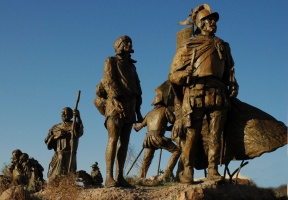By Daniel Nardini
 I have always said that we all must learn our history, and what it means good as well as bad. We must also bear in mind that history is not always so black and white as too many people make it out to be. This is very true in the State of New Mexico, where diversity is the reality of everyday life, and this everyday life is a product of its history. Long before the Spanish ever set foot in that area, the Native Americans had inhabited the area for centuries. This includes the Navajo, the different Pueblo peoples, the Ute, the Apache, and the Comanches. Long before the Spanish ever explored the area, these native peoples lived with each other, and yes often warred with each other. Then the Spanish under Juan de Onate conquered most of what is now New Mexico, and with Onate came thousands of Spanish colonists (many of the descendants of these early Spanish colonists remain in New Mexico). Onate became the first Spanish governor of the territory, and he was quite cruel to the native peoples. To be fair, he was also quite cruel to the colonists as well.
I have always said that we all must learn our history, and what it means good as well as bad. We must also bear in mind that history is not always so black and white as too many people make it out to be. This is very true in the State of New Mexico, where diversity is the reality of everyday life, and this everyday life is a product of its history. Long before the Spanish ever set foot in that area, the Native Americans had inhabited the area for centuries. This includes the Navajo, the different Pueblo peoples, the Ute, the Apache, and the Comanches. Long before the Spanish ever explored the area, these native peoples lived with each other, and yes often warred with each other. Then the Spanish under Juan de Onate conquered most of what is now New Mexico, and with Onate came thousands of Spanish colonists (many of the descendants of these early Spanish colonists remain in New Mexico). Onate became the first Spanish governor of the territory, and he was quite cruel to the native peoples. To be fair, he was also quite cruel to the colonists as well.
A Pueblo leader named Pope launched a revolt against the Spanish and drove most of them out. Some Spanish colonists sought refuge with friendly Pueblo tribes, but most Spanish colonists escaped to Mexico. Onate was tried by the Spanish Crown and was forbidden from ever going back to what is now New Mexico. Interestingly enough, 12 years after this successful revolt, most of the Pueblo peoples sought the help of the Spanish when they were viciously attacked by their traditional enemies the Navajo and the Apaches. Until Mexico had become an independent country, the Spanish would rule what is now New Mexico for a couple more centuries. The statues that had been built of Juan de Onate were put up by the descendants of the Spanish colonists who had moved from Mexico. For many years, the native peoples had hated and despised the statues to Onate and any and all Spanish individuals. The growth of the Black Lives Matter movement, plus the rise of Antifa and the corona virus epidemic has led to even more protests, riots and bloodshed in New Mexico and calls to take down the statues of Onate.
The statues of Onate have been taken down, but it has caused extreme resentment among many of the people of New Mexico whose ancestors are Spanish. Also, many of these New Mexicans complain that they resent statues dedicated to Pope because he had massacred 400 Spanish men, women and children during his revolt. Statues and memorials to Pope have not been taken down. A few years back, I had spoken against the political right in Arizona trying to suppress history and all the grim conflicts that had been part of the history in the southwest in order to preserve an unrealistic “harmony.” Likewise, I am equally against a left wing, Marxist interpretation that stresses a one-sided view that the United States and everything western and European is inherently evil, wicked and is filled with nothing but racism, inequality and oppression. If this were true, the United States we know today would not exist. Destroying statues, public property, and even private property is a prelude to erasing history. Rewriting textbooks, teaching history in solely black and white terms, and trying to “stir up the masses” is as evil and unacceptable as trying to suppress the unpleasant aspects of history to keep an artificial harmony. What, in my view, should be done, is learn from the mistakes from our ancestors to try and keep an open dialog on how we can get along.
 Villanueva-Backed Law to Protect Access to Illinois Courthouses December 11, 2025
Villanueva-Backed Law to Protect Access to Illinois Courthouses December 11, 2025









Destroying Statues in New Mexico
By Daniel Nardini
A Pueblo leader named Pope launched a revolt against the Spanish and drove most of them out. Some Spanish colonists sought refuge with friendly Pueblo tribes, but most Spanish colonists escaped to Mexico. Onate was tried by the Spanish Crown and was forbidden from ever going back to what is now New Mexico. Interestingly enough, 12 years after this successful revolt, most of the Pueblo peoples sought the help of the Spanish when they were viciously attacked by their traditional enemies the Navajo and the Apaches. Until Mexico had become an independent country, the Spanish would rule what is now New Mexico for a couple more centuries. The statues that had been built of Juan de Onate were put up by the descendants of the Spanish colonists who had moved from Mexico. For many years, the native peoples had hated and despised the statues to Onate and any and all Spanish individuals. The growth of the Black Lives Matter movement, plus the rise of Antifa and the corona virus epidemic has led to even more protests, riots and bloodshed in New Mexico and calls to take down the statues of Onate.
The statues of Onate have been taken down, but it has caused extreme resentment among many of the people of New Mexico whose ancestors are Spanish. Also, many of these New Mexicans complain that they resent statues dedicated to Pope because he had massacred 400 Spanish men, women and children during his revolt. Statues and memorials to Pope have not been taken down. A few years back, I had spoken against the political right in Arizona trying to suppress history and all the grim conflicts that had been part of the history in the southwest in order to preserve an unrealistic “harmony.” Likewise, I am equally against a left wing, Marxist interpretation that stresses a one-sided view that the United States and everything western and European is inherently evil, wicked and is filled with nothing but racism, inequality and oppression. If this were true, the United States we know today would not exist. Destroying statues, public property, and even private property is a prelude to erasing history. Rewriting textbooks, teaching history in solely black and white terms, and trying to “stir up the masses” is as evil and unacceptable as trying to suppress the unpleasant aspects of history to keep an artificial harmony. What, in my view, should be done, is learn from the mistakes from our ancestors to try and keep an open dialog on how we can get along.